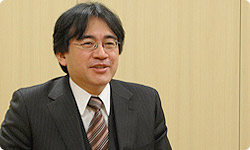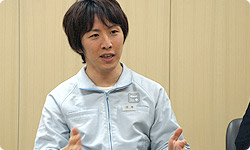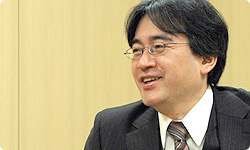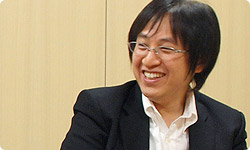2. A Little Becomes a Lot
Since Miyamoto-san and I each had different definitions of Chotto, you couldn't get off to a good start making A Little Bit of Brain Training.
So I asked you and Miyamoto-san to sit down and discuss what you meant by Chotto. (laughs)
Nintendo's president and its senior managing director sat down for a serious debate about the precise meaning of Chotto. That's a little odd.
And the result was that there was no need to force a specific, narrow definition.
We thought letting Chotto mean lots of things might be best. That was the conclusion we settled on in the end.
In the end, allowing Chotto to have a broad meaning also worked out well for us, the developers.
When you started making it, what did you do to Chotto-ise it?

We considered a number of ideas. For example, in the Brain Training games so far, after you had completed a game and received a stamp, the game returned to the stamp calendar. The point of that was to encourage players to play more, but with A Little Bit of Brain Training, after you get a stamp, a message comes up telling you to return to the menu. Just by doing that, we've provided players an opportunity to stop playing for a moment and return to the menu.
So in order to have players enjoy the game little by little, you periodically display messages that allow users to stop for a while. That's completely the opposite from most games. Most games are designed to discourage players from stopping. In other words, by periodically saying, "This is a stopping point,” busy users will feel that they can play it without taking up too much time.
That's right.
But when you're playing the game, it's a little weird. After you finish a game, it's like the game is asking, "Do you want to stop?” I've never been asked that by a game before, so it felt really weird. (laughs)
Yeah. (laughs) A more subtle detail is that it always displays the current time. The DS has an internal clock, so we simply decided to display that.
I think it has a big effect.
I suppose so. It may just be psychological, but when you're playing it on the train, you know your arrival time. With the current time displayed right there on the screen, you don't have to worry about missing your stop.

Was it you who decided to display the time on the Wii News and Forecast Channels?
I like clocks! (laughs) Also, before you begin a particular game, it displays how much time it will take, for example two or five minutes, as the case may be.
I like that. If you know how many minutes it will take to play a particular game once, you can easily decide whether you have time for it. Did that idea come together smoothly?
Yes, for the most part. But...
But?
But as far as size went, we wondered a lot about how much could appropriately be called Chotto. When it came to the Nintendo DSi software for download, no particular size, standard or guidelines had been set.
When there aren't any standards, you have to set them yourself as you develop the software.

So when it came to the games to be included in A Little Bit of Brain Training, I wavered back and forth about whether to simply select some from past games or to make new ones.
At the time, when I was asked, "Is this enough?” I responded, "Shouldn't we push some new games to the fore?” I thought that would be more fun for players.
So then we decided to add new games. But we added a little, and then a little more, and it grew rapidly, quickly, bigger, until the next thing I knew, it was bigger than More Brain Training!
When it was supposed to just be Chotto!
It wasn't Chotto any longer!
I was like, "What happened?!” (laughs)
I suppose you'd understand if you counted the number of puzzles. (laughs)
I couldn't bear to part with any of the games, so I would leave them in, thinking that having plenty of variation would be good. I was still in the mindset of the previous games. Meanwhile, it got bigger than they had been! Perhaps I could have done a little better in that area.
So I asked him if we could split it in two.

Yeah. I knew it wouldn't be easy, but it wasn't impossible either. So I suggested splitting it into a Maths Edition and an Arts Edition.
There was nothing else to do.
When I heard that, I thought we should run with it.
So I flew to Sendai to ask Dr. Ryuta Kawashima at Tohoku University if splitting it into arts and science would be all right, and he gave his consent. He said that a difference in a player's Brain Age4 might arise between the two, so players would get a sense for whether they were more arts or science oriented.
4Within the context of this software, "Brain Age" refers only to a game score. It is not a scientific value.
Fascinating...